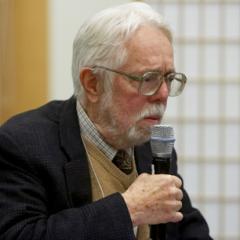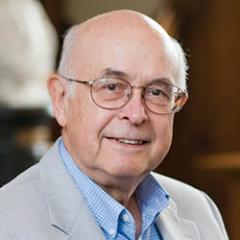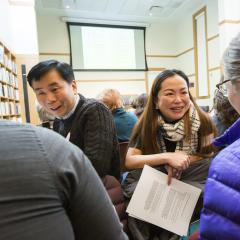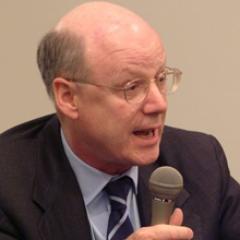Harvey Cox Interview: Faith Beyond Fear and Hierarchy
Harvey G. Cox Jr. was Hollis Research Professor of Divinity, Harvard Divinity School, and is the author of many influential books, including his bestseller of 1965, The Secular City. Among his more recent titles is The Future of Faith, published in 2009. During 2010, Masao Yokota spoke with Professor Cox about key themes from the book, with excerpts from these conversations grouped into two main topics, “The Meanings of Faith” and “The Age of the Spirit.” As a coda to these discussions we have added a brief exchange between Yokota and Cox that followed the latter’s address at the 2012 American Academy of Religion (AAR) annual meeting called “From the Bottom and the Edges.”
I. The Meanings of Faith
In your new book, The Future of Faith, you quote Aldous Huxley’s novel Island. Why did you choose that quote?
Huxley was a very interesting thinker and prolific writer. He was viewed as a kind of maverick, but he was a truly interesting man. I met him once about 30 years ago. His emphasis in that quote is on how religion doesn’t have to do or shouldn’t have to do with beliefs. He writes, “Give us this day our daily Faith, but deliver us, dear God, from Belief.” That is wonderful, I love that.
I am very curious why you didn’t title the book The Future of Religion. Instead you titled it The Future of Faith. Would you please explain?
I think faith is a broader and more inclusive category. There are a lot of people today who say that they are not religious but are spiritual. The category of faith would include them, in my opinion. Religion for many people is associated with institutional expressions of creeds and particular practices — this is part of it, but not the whole thing. It is not all that faith means. Faith is a bigger category.
I wonder if you can you discuss something Daisaku Ikeda says in one of his poems, which is that “Faith means to fear nothing.” In many cases faith does mean fear, or is used as a means to control people.
In talks I have cited a Biblical text of a story about Jesus who is out in a boat with his disciples (they are fishermen) and a big storm comes up and they are all terrified. Jesus said to them, “Fear not, but have faith.” For him also, the opposite of faith is not unbelief; the opposite of faith is fear. Even worse, when faith becomes associated or identified with fear, that is very bad. It is very destructive.
Sometimes we fear differences, but we also have a fear of ourselves. We really have to overcome these fears.
That is true and it is not easy to do. One of the problems today is the certain kinds of leaders in this country and possibly other countries who encourage fear. They build up an atmosphere of fear, uncertainty, so that people can be led in certain directions, including to build up the military to purportedly protect people. A lot of this is artificially induced fear.
What then is the real essence of faith?
It derives from the Latin word fides, which is related to fidelity or being committed to something, being loyal. Another way of saying it would be having a loyalty to something, to a vision, a hope, and a person. It has to do with a central part of one’s life. Beliefs are of a different sort — sometimes you doubt them, sometimes they come back, sometimes you discard them. But faith is more existential and I like to think of as a form of loyalty.
Have you ever heard of the American philosopher Josiah Royce? He wrote a whole book on the philosophy of loyalty and how sometimes the big mistake we make in life is being loyal to the wrong things. I think that is true.
I strongly believe that we have been badly misled in the last 100 years by attaching loyalty to the national state and making that our highest form of loyalty, which gives us our identity by this loyalty. It’s really kind of ridiculous. The wars of the twentieth century had to do with millions and millions of people sacrificing their lives because they had loyalty to this flag, or this emperor; it’s destructive. Your loyalty should be directed to much wider and broader humanity, not just to a state.
There are over 210 national states in the world now. There was a time in this country in the early nineteenth century when some people were loyal to their local state, for example Virginia or South Carolina, and would even die for it. Today, who is going to die for Virginia or New Jersey? The time may come when dying for America or dying for Japan will seem as outmoded as dying for Virginia or New Jersey.
I recently saw a documentary on one of the final chapters of the WWII movies about the last days of the war between Japan and America (after Germany had surrendered). There is some footage of these young men, kamikaze pilots, having their last toast before they go off. They were saying, “Die for the Emperor!” What a terrible waste! The misplaced loyalty. If you think of faith as a kind of loyalty, it can be misplaced. You can have faith in the wrong things.
What do you consider as good loyalty?
The most basic kind of loyalty is to that which is of the highest and most inclusive value. One that doesn’t exclude anybody, including animals, plants, or anything else.
The most basic kind of loyalty is to that which is of the highest and most inclusive value.
Harvey Cox
II. The Age of Spirit & the Decline of Hierarchy
What do you mean by the Age of Spirit?
It is hard to know the dating of this, but for more and more people today, Christianity does not mean subscribing to a particular creed. It means a going back to the example and inspiration of Jesus and trying to live that way the best you can within community. It means having different forms of worship, and different styles of organizations, where they are not all the same. I call this the Age of the Spirit because it really is the spirit of the Gospels or the spirit of Jesus that unites. It isn’t institutional or creedal elements that unite people. It is this participation in the same spirit.
Why do you think the Age of Spirit is emerging right now?
Good question. There are a couple of things. One is the recognition on the part of a lot of people that “my religion is one among many and not the only one,” so the question becomes one of what do I have in common with these Buddhists or Muslims. This didn’t use to be quite as self-evident. If you lived in a particular country, you were Hindu or Buddhist. This is one factor: diversity that is more and more self-evident.
The other is the advance of science and technology, which teaches people to question beliefs that don’t seem to have any proof. You are taught to question until some kind of experiential proof emerges. I think this whole mentality, temperament has quietly spread at least in some places in the modern world, though maybe not everywhere, and at different speeds. This is a favorable development for Christianity, and maybe for the other religions, because it relieves Christianity of trying to assert unproven statements about the universe, such as when it was created, the whole Creation debate. This is not the point anymore. I think this is happening.
There may be some other factors but as far as Christianity is concerned, there are so many people in the world now who realize the poverty and squalor they live in is not necessary; it doesn’t have to be that way. There were many centuries when they didn’t know there was any other possibility. Now because of worldwide communications, people can see that. This thirst and this anger for a more just world is a part of what brought about this Age of Spirit. I think it is an important component of it.
What are the critical characteristics of the Age of Spirit?
In The Future of Faith I describe three stages in the history of Christianity, which I call the Age of the Faith, the Age of the Belief, and now most recently the Age of Spirit. This Age of the Spirit has some distinctive qualities; one is a more egalitarian and less hierarchical view of religion. Another is openness to conversation, learning and dialogue with other religious traditions. Third is the increased leadership of women.
However when one looks outside of Christianity itself, one cannot help noticing similar trends in developments in other world religious traditions. In my book, I included the Soka Gakkai movement as an example in the Buddhist tradition of this movement from this hierarchy to egalitarianism, to ecumenical interfaith openness and to commitment to human rights and peacemaking. I included that along with movements in other faiths including Judaism and Islam. The most striking thing for me is that as Soka Gakkai embraced, and continues to embrace, this spirit of the Age of the Spirit, it continues to flourish and grow.
How is friendship important in the Age of Spirit?
It is important to me that when Jesus said to his disciples “Do not call me master, call me friend and I will call you friends.” Then he did a very radical thing for a rabbi or religious teacher in his time, he washed the feet of his disciples (which is usually done by a servant, but he made himself a servant to them), really emphasizing there would not be this hierarchical experience and encouraged them to wash each other’s feet. In those days, your feet were pretty dirty because the roads were very dusty and people wore sandals. Before you could enjoy a meal or hospitality, somebody would wash the feet of the guest. He did this and it is a very important symbolic gesture.
I know the same is true of the Buddha and also of Mohammed, who emphasized the egalitarian aspect that all are on an equal basis under the one God. Mohammed treated his followers as equal as well. This was present in some early stages of these religious traditions, but then they tended to develop into a more hierarchical pattern. What I can observe happening now is at least the beginning of the dismantling of this hierarchical pyramidal structure and a more egalitarian way of governing and relating to each other and emerging. It will have setbacks, and there are anti-egalitarian movements in all things, including the fundamentalist wing of Christianity. And I am sure there are also such things in Buddhism, certainly in Hinduism and Islam. But nonetheless the overall long-range title change is in this direction of a more egalitarian arrangement.
I know Daisaku Ikeda always tries to break down the walls between him and others. [Here Center president Richard Yoshimachi adds that this is something Mr. Ikeda learned from his mentor, Josei Toda, who treasured and valued those others considered as occupying the bottom of society.]
It occurs to me there is a difference between Japan and the United States in this respect. Traditionally, Japan has been a very hierarchical society. As a foreigner thinking about going to Japan, you can buy handbooks to let you know how far you need to bow, depending on who the person is. You can never truly learn this as a Westerner but still there is a code of hierarchical structure that would be hard to run against.
In America, we have an egalitarian rhetoric but under that rhetoric here there is considerable hierarchical structure depending on money and power, which often go together. There was a time when you could almost tell where people belonged on a social ladder by how they dressed and talked. Now it is not so easy to do. People with a lot of money now dress casually. Those with not so much dress up a lot. Still we have not overcome the top down hierarchical structure of the society even though rhetoric is against it. There are two different societies here, so the hierarchical mentality needs to be challenged in different ways because they are two different cultures but it is important to do.
When the religious movement, the Friends, emerged in the seventeenth century in England, they were called Quakers (their official name is “Society of Friends”). They took this teaching of Jesus very seriously, saying, “We are all friends.” Therefore, they would not give even the slightest symbolic difference to people of higher rank. The English language at the time made a distinction between “you and I and thee and thou.”
“Thee and thou” were used with people at the same rank as yourself. The Quakers insisted on saying that to everybody and they would not take their hats off. They were severely punished, painfully persecuted because if someone like a lord or an admiral or a duke, say nothing of royalty would come by, you were supposed to take your hat off. They wouldn’t do that, they kept their hats on and were whipped or worse, simply for refusing to do that gesture of dereference of hierarchy.
My ancestors were Quakers who had to leave the United Kingdom because they were persecuted. They came to Pennsylvania when William Penn first came over so I have this in my blood. There are so many ways in which my grandparents and my parents and others were very critical of any kind of pomposity or what we call “pulling rank.” It was one of the major reasons why Quakers intensely dislike the military.
First of all, as a follower of Jesus you are not supposed to engage in any violence. Quakers are non-violent. But also, all these ranks, corporals, majors, colonel, and generals, the military is so clearly ranked and hierarchical. They didn’t like that at all. I grew up with this sort of inherited distrust for both the violence of the military and the hierarchical system.
I learned as part of their practice, Quakers create a circle and not where someone stands in front and preaches. Also, Soka Gakkai traditionally cherishes dialogue in small group discussion meetings.
The feeling is the same. The Quakers traditionally meet in a way such that anyone who feels moved by the spirit speaks. Others sit in silence. It is almost Zen-like. They sit, then someone will speak. Then someone else might speak, maybe in response or maybe just to say something on their own.
III. Creativity at the Edges
I was really inspired by your recent talk at AAR. You said creativity thrives at the edges — at the borders and the bottom. Would you explain a bit?
Well, this is something that has interested me for a very long time. When I received this invitation to give this major address at the AAR, I thought at long last I will have a chance to really get this out. So I worked on it some more. The issue that has always been in my mind is very rarely does real creativity in religion or in anything else — philosophy — start at the top. It starts at the bottom, it starts at the edges. And then somehow works its way up or in. One of the reasons of course is that the people at the center and at the top see no need for change. Things are going pretty well for those people. In fact they would even have a tendency to be somewhat resistant to change. But you can think of countless examples. Even the people who were born into a privileged position had to take a marginal position in order to be creative. Let me give you a couple of examples from my own tradition.
Jesus is born out in what we would call the boondocks. He’s not from Jerusalem. He’s up there in Galilee and it’s kind of a border country. According to the Bible, he was born in Bethlehem but grew up in Nazareth. It was out on the edge, viewed at that time as very provincial. Martin Luther comes from the wastelands of northern Germany. He doesn’t start in Rome. Gautama is born into privilege but he leaves and goes out and lives on the edge. His insight comes from when he has distanced himself from the center and the top and the privileged.
Once in awhile there is an exception but by and large there are two reasons I can see. One is the people at the top are not inclined to want to have any kind of change or creativity because they understand in some ways the structure is not completely stable but they count on that structure to preserve their position of privilege. They are nervous about these guys, any suggestion of change. The other reason, however, is when you are on the bottom, you are on the edge of something. There is something outside of that edge. It’s maybe another culture, another religion, another philosophy. You are closer to it and the possibility of mixing is more open to you. A lot of times this creativity comes from the admixture of elements. It creates something new. That happens a lot.
So I worked that out and I gave a couple of examples as you recall. One was this wonderful example of visiting this old village in rural Mexico where they told me our Lady of Guadalupe had a husband. El senor! Well I had never heard of him. But there it was. They were exercising a kind of creativity, which had they been in the center of things, would have been banned. But who knows what will happen to that. I call it the hieros gamos — sacred marriage — of beauty, benevolence and compassion on the one side and on the other this Spanish caballero with his sword, which represents power. A lot of people are looking for that combination of compassion and power either consciously or unconsciously. I’m sure that’s what they were doing.



